|
Round 21: Featuring
our European cousins: Ryman & Dabach, Liam Churchill, Alan Herridge, Roy Phelps, Lee Anders-Hasselstrom, Roland
Pratt, Phil Elson, Ron Picardo, Dennis Priddle, Clive Skilton, The Stones, and more!
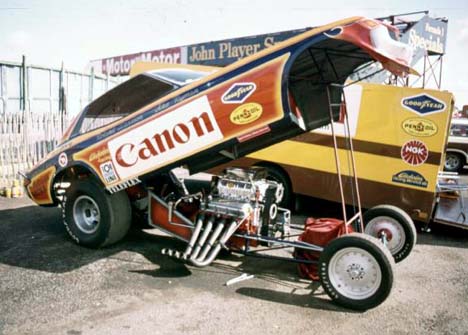
There was a big to-do from the press in 2002 about Toyota entering the realm of funny car racing, as if to say it had never had been done before. Let's flash back to Sweden and the year 1974. Funny car racing was just getting started in Europe, so variety was the norm. There were Vauxhalls, Opels, Volvos, Reliants, and yes, the first Toyota. The Swedish team of Ake Ryman and Leif Dabach debuted their Chevy-powered Toyota Celica sponsored by Canon Cameras in 1974. The car was not a major success, running low sevens, but in Europe, that was enough to get by. The duo shared driving duties at first with Leif Dabach doing most of the driving and finally taking over full time. The team finished out the decade with a more standard and more powerful Dodge Challenger.
(Alan Currans photo; info sources Trakbytes, the Acceleration Archives, and draglist.com)

Liam Churchill of Great Britain had the first funny car named The Sting, predating Larry Coogle's version. Churchill debuted his Ford Capri with Chrysler power in 1975. Churchill was ever the showman with long burnouts and the team's clean presentation exceeding the car's actual performance. (Alan Currans
photo; info sources Trakbytes, the Acceleration Archives, and draglist.com)
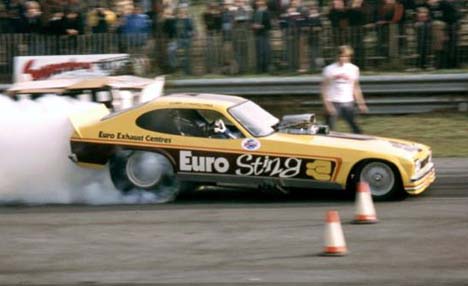
The original Sting pictured was short-lived and was replaced by a newer, more flashy Capri. The new car also was called The Euro Sting after picking up sponsorship from
Euro Exhaust Centres. Churchill retired at the start of the new decade. (Alan Currans
photo; info sources Trakbytes, the Acceleration Archives, and draglist.com)
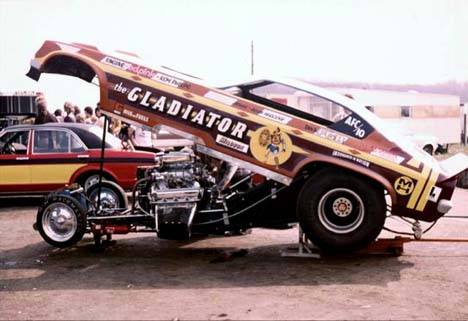
The Gladiator 74 Vega was one of Europe's best funny cars of all time. The former Chadderton & Okazaki car was imported by Santa Pod owner Roy Phelps for a series of match races. Original driver Leroy Chadderton and fellow ex-fuel altered driver Dale Emery both drove the car while still in the Chadderton & Okazaki paint scheme at Santa Pod. Emery experienced one of Europe's first fireballs while at Santa Pod running a 6.99 best. The car was turned over to Santa Pod team driver Allan Herridge in
1976, who repainted the Vega to the unique Gladiator paint job. He raced the Gladiator from
76-79, running a 6.51 best with the Milodon powered car.
(Alan Currans photo; info sources Trakbytes, the Acceleration Archives, and draglist.com)
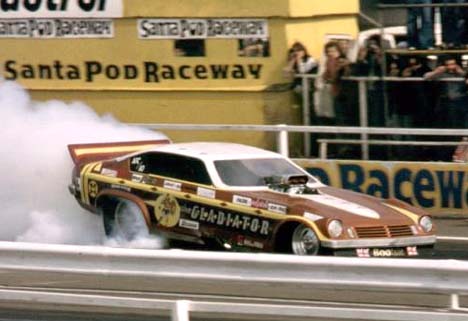
The car was turned over to Europe's first five-second racer Peter Crane in 1980. It was repainted and called the Hustler after a pull cord toy funny car sold by Santa Pod Raceway. The car never performed up to Crane's standards and he quit. Phelps next let Bill Sherratt and Chris Filsel race the car as the Rain City Hustler on alcohol as a try out for a nitro job. Sherratt got the Cannonball Arrow and Filsel got the Grass Cutter Arrow. The Gladiator was last raced in AA/FC by
Geoff Bosworth as the Mad Max in 1985 at the annual Cannonball race. (Alan Currans
photo; info sources Trakbytes, the Acceleration Archives, and draglist.com)
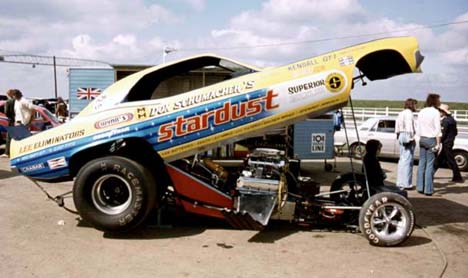
Herridge, like other top British drivers of the day, raced both Top Fuel and Funny Car.
He had been driving the ex Don Schumacher Stardust Cuda to the best of 6.66 in 1975 and had
driven the Asphalt Alleygator series of top fuelers. (Alan Currans photo; info sources
Trakbytes, the Acceleration Archives, and draglist.com)
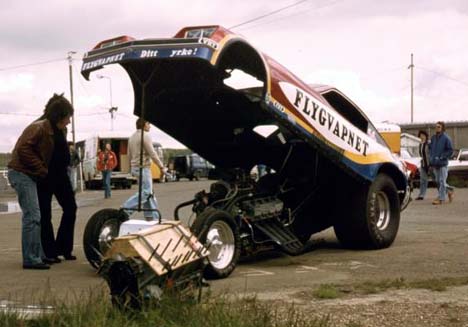
What does Flygvapnet mean? It stands for the Swedish Air Force,
which sponsored Lee Anders-Hasselstrom in the late seventies and early eighties. Like the American armed forces-sponsored funny cars of the seventies, the Flygvapnet Monza funny was among Europe's
best. Hasselstrom (as seen in the photo) had a rarity in that day -- a European funny car with a spare block. The car was a consistent mid six-second runner on the best of the European tracks like Santa Pod and Mantorp Park in Sweden. It was a frequent winner in races where racers from the U.S., Norway, and Sweden got together. Hasselstrom
later ran the Coca-Cola Camaro, recording an excellent 5.99 in 1985, one of the first fives in Europe. Unfortunately, Hasselstrom lost his life in a funny car fire the following year. (Alan Currans
photo; info sources Trakbytes, the Acceleration Archives, and draglist.com)
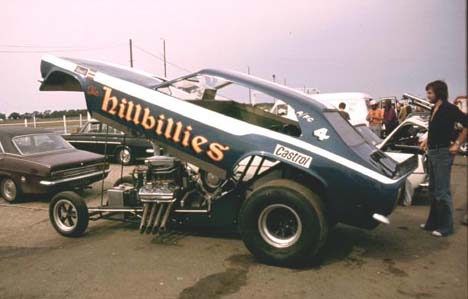
The Hillbillies Vauxhall funny car was a middle of the pack racer from Great Britain in the mid seventies. The team stepped up to nitro funny cars from an A/FA Fiat Topolino. The car pictured was the team's second body on this chassis. This more swoopy body replaced the team's original Reliant
Scimitar. The Reliant had suffered from aerodynamic problems similar to the Vega Panels of the seventies. The car was driven by Roland
Pratt, who also drove Clive Skilton's Top Fueler to low seven-second times. While not a big winner, the team was very competitive with the likes of Priddle, Herridge, and Haywood. (Alan Currans
photo; info sources Trakbytes, the Acceleration Archives, and draglist.com)
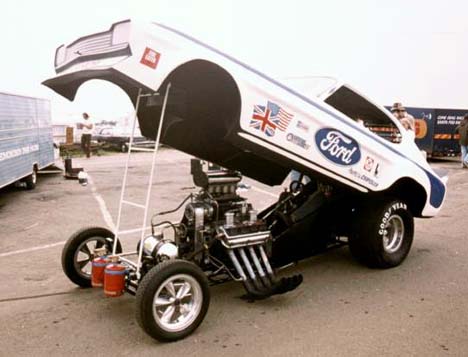
The Sneaky Gloworm Ford Capri funny car was never a major threat to win in Great Britain. This did not deter Phil Elson from racing in the mid-seventies. The car began as an AA/Fuel Altered with several changes made throughout the years. The funny car body was added after the AA/FA chassis was rebuilt. Elson went funny car racing when they became popular in Great Britain and AA/FAs
were being phased out. The 392 Chrysler powered Ford product was good for seven second times. Phil Elson, Roland Chaplain, and Ron Picardo all took turns at the wheel from 1975 to 1977. Graham Stockley later raced the car under the Entertainer name with little success. (Alan Currans
photo; info sources Trakbytes, the Acceleration Archives, and draglist.com)

The Force was part of the Roy Phelps Santa Pod Dragway racing team from 1978 to 1981. Car painter Ron Picardo, who also had driven the Firefly and Highway Patrol fuelers for Phelps, drove the car. The
Chevy Monza had been Gene Snow's and was imported into Great Britain at the same time as his Arrow funny car. Picardo took a test run in it while still painted in Snow's colors. Picardo liked the car and Phelps bought
it. Picardo repainted the car with the Force colors. Phelps also imported the STP Duster, the Stardust Cuda,
the Chadderton & Okazaki Vega, the Army Arrow, the Gene Snow Arrow, the Blue Max Mustang II and Arrow, the Showtime Corvette, and other floppers during the seventies. (Alan Currans
photo; info sources Trakbytes, the Acceleration Archives, and draglist.com)
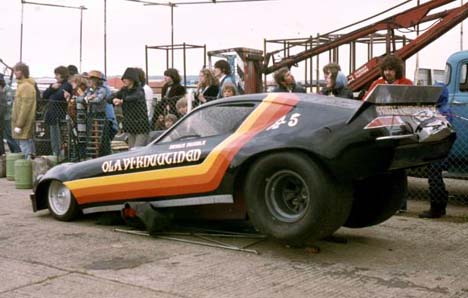
This funny car teamed a very rich Swede named Olavi Knuutinen and British racer Dennis Priddle. Priddle was a talented chassis builder. He was also a powerhouse both
in nitro funny cars and top fuel dragsters in Great Britain. This was Priddle's second funny car, replacing the Donovan-powered Avenger that ran the first six-second funny car times in England. Top times for this team were 6.59 at 212.61 in 1977 with a late model Keith Black Hemi. (Alan Currans
photo; info sources Trakbytes, the Acceleration Archives, and draglist.com)
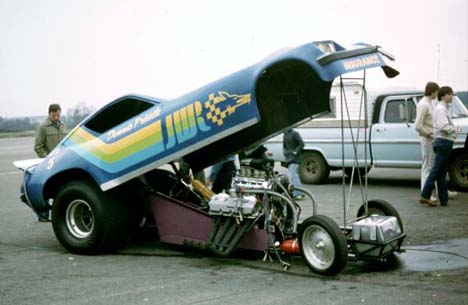
Olavi's interest in racing soon waned and Priddle took the car on his own. The car later was replaced by a new lower-built Monza. Priddle
gave up funny cars altogether in the early 80s to race Top Fuel full time before retiring
in 1985. (Alan Currans photo; info sources Trakbytes, the Acceleration Archives, and
draglist.com)
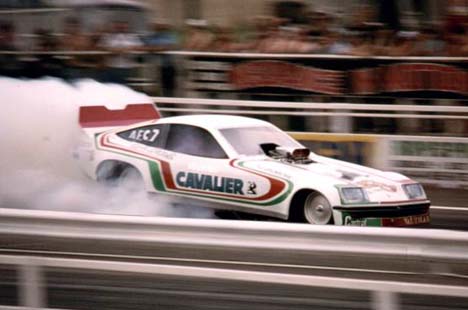
Clive Skilton was more famous as a Top Fuel Dragster
pilot, but like many other British racers of seventies, he also raced a funny car in order to run more often. Both of Skilton's funny cars were sponsored by Castrol and had Hemi power. The car pictured is not a Monza but a Vauxhall Cavalier
built in 1977. The car had six-second potential like its predecessor, but was seldom run. Clive moved to the U.S. full time in
1977, where he raced the NHRA Top Fuel tour and finished runner up to Shirley Muldowney at the
NHRA Springnationals. Today, Clive lives in California and runs a new car dealership. (Alan Currans
photo; info sources Trakbytes, the Acceleration Archives, and draglist.com)
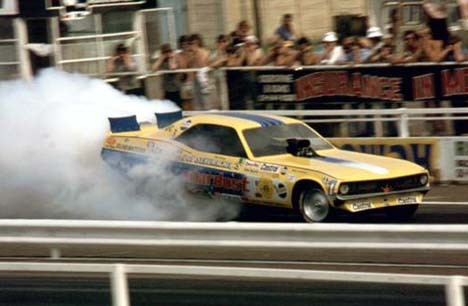
The Stones racing team of Great Britain was one of the most beloved teams in British racing history. The team raced funny cars, top fuelers, fuel altereds, alky dragsters, and
sportsman classes. The Stones bought the ex-Schumacher Stardust Cuda from Santa
Pod's Roy Phelps and did well with it. (Alan Currans photo; info sources Trakbytes,
the Acceleration Archives, and draglist.com)
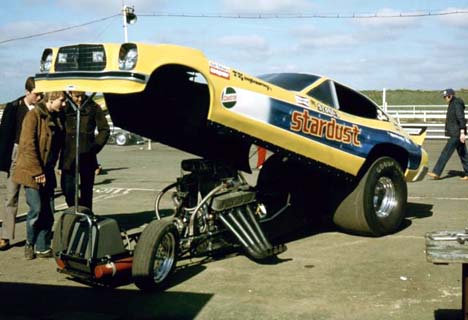
The Stones' second funny car replaced the
Cuda, but the Stardust name remained. They bought this car from Roy Phelps as
well. It was the 1976 Mustang II of Texan Raymond Beadle. Phelps had hired Beadle to race in England from
78-80 whenever possible. The Stones were Chevy die-hards and kept a Chevy in this car when it debuted in 1978. The car later ran a best of 6.49 at 212 with Hemi power, but burned to the ground in 1983. (Alan Currans
photo; info sources Trakbytes, the Acceleration Archives, and draglist.com)
[ Back ] [ Home ] [ Next ]
|
